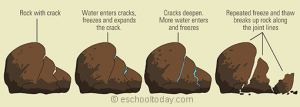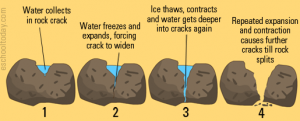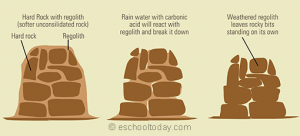What is Weathering?

Weathering is the breaking down of rocks, soil and minerals as well as wood and artificial materials through contact with the Earth’s atmosphere, biota and waters. Weathering occurs in situ, roughly translated to: “with no movement”, and thus should not be confused with erosion, which involves the movement of rocks and minerals by agents such as water, ice, snow, wind, waves and gravity and then being transported and deposited in other locations.
Types of Weathering
Weathering is the first step in the formation of soil. Weathering takes place in four ways: Mechanical or Physical weathering, Chemical weathering and Organic Biological weathering
- Mechanical or Physical Weathering :
Mechanical weathering is also known as physical weathering. Mechanical weathering is the physical breakdown of rocks into smaller and smaller pieces. One of the most common mechanical actions is frost shattering. It happens when water enters the pores and cracks of rocks, then freezes. Frost weathering, frost wedging, ice wedging or cryofracturing is the collective name for several processes where ice is present. These processes include frost shattering, frost-wedging and freeze-thaw weathering.
Once the frozen water is within the rocks, it expands by about 10% thereby opening the cracks a bit wider. The pressure acting within the rocks is estimated at 30,000 pounds per square inch at -7.6°F. Over time, this pressure alongside the changes in weather makes the rock split off, and bigger rocks are broken into smaller fragments.
Another type of mechanical weathering is called salt wedging. Winds, water waves, and rain also have an effect on rocks as they are physical forces that wear away rock particles, particularly over long periods of time. These forces are equally categorized under mechanical or physical weathering because they release their pressures on the rocks directly and indirectly which causes the rocks to fracture and disintegrate.
Mechanical/physical weathering is also caused by thermal stress which is the contraction and expansion effect on the rocks caused by changes in temperature. Due to uneven expansion and contraction, the rocks crack apart and disintegrate into smaller pieces

The illustration shows how a rock can undergo physical weathering.
The different processes of Mechanical or Physical Weathering
Wind :
: The physical forces of wind act on the loose rocks, leaving them sculptured and denudated. Wind forces carry small particles and rocks that collide with the rocks, in turn, wearing then away. The forces of wind on physical/mechanical weathering are common in sandstorms in deserts.
Water and Glacial Materials :
: Water, on the other hand, gets into the rocks and once inside the rocks and freezes. The frozen water expands and causes the rocks to weaken and widens the cracks. In the long-run, the bigger rocks are broken into smaller and smaller fragments. Moving ice in glacial areas also washes away rock fragments and disintegrates them into smaller pieces as the rocks interact with the forces and pressure of the frozen materials.
Temperature Fluctuations :
Fluctuations in temperature contribute to thermal stress. This is the contraction and expansion effect on the rocks because of temperature changes. Because of the uneven expansion and contraction, the rocks crack and disintegrate into smaller pieces. Eventually, these processes make the rock break down into finer and finer pieces.
Types of Physical Weathering
The various categories of physical/mechanical weathering are determined by the natural processes and physical forces. They include
Thermal Pressure :
Changes in temperature contribute to expansion and contraction of the rocks. When the temperature of the rock rises, the rock expands and when the temperature of the rocks decreases, the rock contracts. Because the outer surface is more exposed than the inner surface, there is uneven contraction and expansion of the rock’s constituent minerals. This process results in physical stress, also termed as thermal pressure, which can crack or break the rock apart.
Rocks in the desert are highly affected by this process because during the day the temperatures are very high while in the night the temperatures are low. The continuous contraction and expansion during the day and night exert stress of two main types, thermal fatigue, and thermal shock, on the rocks which makes them to crack and eventually break into pieces. Wildfires can as well cause considerable weathering of the rocks as the intense heat rapidly expands the rock’s constituent minerals than normal.
Freeze-thaw :
Freeze-thaw also refers to frost chattering or frost weathering. When water enters the rocks through the pores and cracks, it freezes. Once the frozen water is within the rocks, it expands by about 10% thus opening the cracks a bit wider. The pressure acting within the rocks is estimated at 30,000 pounds per square inch at -7.6°F.
Over time, the repeated frost cycles of ice formation and ice melt alongside the changes in weather make the rock split off, and bigger rocks are broken into smaller fragments. Frost weathering is common in mountain areas and very cold regions where the temperatures are about the freezing point of water.

Release of Pressure or Exfoliation :
When the overlying rock materials are stripped by abrasion or other erosion processes, it gives rise to cracking, fractures and expansion of the underlying rocks parallel to the surface. This makes the underlying rocks to release the pressure in them.
Over time, sheets of rock separate from the stripped rocks and break into smaller pieces along the fractures through a process termed as exfoliation. Exfoliation happens when cracks form parallel to the land surface as an effect of the pressure release during abrasion, retreat of an overlying glacier, or rock uplifts.
Salt-crystal Growth or Salt Weathering :
Salt-crystal growth is also referred to salt weathering or haloclasty. It occurs when saline solutions enter the rock pores or cracks and evaporates, leaving behind salt crystals. The accumulated salts crystals are heated up when environmental temperatures are high, and they expand thus releasing pressure on the rock, causing the rocks to disintegrate.
Salt crystallization may also happen when rocks such as limestone form salt solutions like sodium carbonate or sodium sulfate. The salt solutions form salt crystals when the moisture in them evaporates. These salts can expand three-fold or even more, and this phenomenon mainly takes place in drier and high-temperature areas. A prime example of salt-crystal growth is witnessed in honeycombed stones in the sea wall.
Plant Growth and Animal Action :
Trees and other plants can wear away rocks when their roots penetrate into the cracks in the rocks. As the roots get bigger, they exert pressure on rocks and make the cracks wider and deeper, eventually breaking the rocks apart. Burrowing animals such as moles, squirrels and rabbits loosen and disintegrate the rocks in the soil.
Abrasion :
Abrasion is the wearing down of rock particles by friction due to water, wind or ice. The continued vulnerability to these elements gradually breaks down the exposed surfaces of the rocks. It is the action on the rocks by wind, ice, rain, and waves combined.
Chemical Weathering
Chemical weathering occurs when chemicals dissolve in water and then attack and break down rock surfaces. Chemical weathering occurs faster in places with warm temperatures and abundant water, such as in humid tropical environments. During chemical weathering the mineral composition of rocks changes due to chemical reaction with air or water. It results in decomposition of the rocks. Some of the dissolved products of chemical weathering are carried away by water seeping through soil and rocks, a process called leaching. The water eventually may carry these materials to rivers and these to the sea. This is the source of the salinity of the oceans. The examples of chemical weathering are oxidation, decomposition of calcium carbonate etc.

The illustration shows how a rock can undergo chemical weathering.
The different processes of chemical weathering.
Oxidation :
Oxygen combines with minerals, particularly iron. In the rocks containing iron, oxygen combines with iron from iron oxide. The new minerals formed by oxidation become vulnerable to attack by other methods of weathering. The rusting of the iron compounds in the rocks when they react with oxygen in the air gives the affected rocks a reddish brown appearance. The rust expands and helps to break up iron bearing rocks.
Carbonation and dissolving by solution :
When rain water falls, carbon dioxide in the air reacts with it to form a weak acid.carbon dioxide in the air reacts with it to form a weak acid. This acid reacts with several minerals in the rocks.
Bio-chemical Processes :
Various plants and animals can create chemical weathering by emitting acidic compounds. As such, microscopic organisms such as moss, lichens, bacteria, and algae can speed up chemical weathering especially on the rock surfaces where they grow. They release what are termed as acidifying molecules (organic acids and protons) and chelating compounds (siderophores and organic acids). These compounds have the potential of breaking down iron and aluminum minerals in the rocks that are then dissolved by water, resulting in chemical weathering.
Acid Rain :
The resultant acid water from precipitation – (acid rain) reacts with the rock’s mineral particles producing new minerals and salts that can readily dissolve or wear away the rock grains. Chemical weathering mostly depends on the rock type and temperature. For instance, limestone is more prone to chemical erosion compared to granite. Higher temperatures increase the rate of chemical weathering.

Weathering rind in granite produced primarily by oxidation
Types of Chemical Weathering
The various types of chemical weathering arise since it is driven by gradual and ongoing chemical reactions, mineralogy changes, the dissolving of the particles, and then the final wearing away or disintegration of the rocks. These reactions include hydrolysis, carbonation, dissolution, and oxidation. Temperature and most importantly moisture are vital for chemical weathering
Hydrolysis :
Hydrolysis is the chemical reactions caused by water. Water reacts with the rock and alters the size and chemical compositions of the minerals, lessening their resistance to weathering. Whenever minerals are hydrolyzed, crystal rocks and clay minerals such as calcium, potassium, and sodium ions are produced.
This type of chemical reaction is highly common in igneous rocks. The reaction takes either the form of hydration or dehydration. Absorption of water into the rock pertains to hydration while the removal of water from the rock pertains to dehydration. Hydration expands the rock’s volume resulting in size alteration.
This is how gypsum is formed. Dehydration, on the other hand, reduces the volume of the rock. A good example is the formation of hematite from the removal of water from limestone.
Carbonation :
Carbonation is the mixing of water with carbon dioxide to make carbonic acid. Carbonation takes place when the rock minerals react with weak carbonic acid formed when water combines with carbon dioxide in the atmosphere. Carbonic acid acts on the rock by breaking down and dissolving its mineral contents. The dissolved materials are washed away by ground water, and the soluble ions are stored in the groundwater supply. Rocks such as limestone and feldspar experience this type of chemical weathering more. This type of weathering is important in the formation of caves.
Dissolution :
Dissolution equally means leaching. It the process by which the rocks are dissolved when exposed to rainwater. Limestone and rock salts are particularly the rocks that form solvent solutions when exposed to rainwater, surface waters, or even ground water. Upon dissolving, the minerals in the rocks become ion solutions in the water which are then washed away. Karst features are a common example of this phenomenon.
Oxidation :
Oxidation is another type of chemical weathering. Oxidation is also known as rusting. It is the process whereby the rock minerals lose one or more ions or atoms in the presence of oxygen. When minerals in the rock oxidize, they become less resistant to weathering. Oxygen combines with other substances via the oxidation process giving rise to the ion or atom lose.
For instance, iron metal rusts because its ions change from one form to another by losing one electron. It becomes red or rust colored when oxidized. In a similar manner, iron-bearing minerals in rocks go through such a process by losing ions that alter its structure and size from one form to another. The wearing away of the rocks is thus sped up by oxidation/rusting as the resultant oxides are weaker than the original materials. Change of rock colour is a prime example of rock disintegration by oxidation.
Organic or Biological Weathering
Organic or biological weathering refers to the same thing. It is the disintegration of rocks as a result of the action by living organisms. Trees and other plants can wear away rocks since as they penetrate into the soil and as their roots get bplantsigger, they exert pressure on rocks and makes the cracks wider and deeper. Eventually, the break the rocks apart. Some plants also grow within the fissures in the rocks which lead to widening of the fissures and then eventual disintegration.
Microscopic organisms like algae, moss, lichens and bacteria can grow on the surface of the rocks and produce chemicals that have the potential of breaking down the outer layer of the rock. They eat away the surface of the rocks. These microscopic organisms also bring about moist chemical micro-environments which encourage the chemical and physical breakdown of the rock surfaces. The amount of biological activity depends upon how by much life is in that area. Burrowing animals such as moles, squirrels and rabbits can speed up the development of fissures.

The processes of Organic or Biological Weathering
Bio-chemical processes, root penetration, and animal burrowing are some of the processes determining biological weathering. Bio-chemical action plays an important role by emitting organic compounds. The organic compounds have acidifying molecules that corrode rock minerals and as such, makes them weak and prone to disintegration.
This biological action usually results in chemical weathering. The process of root penetration during plant growth exerts pressure on the rocks that subsequently breaks them apart. On the other hand, burrowing animals can break down rocks while some eats away the rock’s minerals.
Types of organic or Biological Weathering
Growing Plant Roots :
It is common to see some roots growing within the face of a rock. Well, such plant activity contributes to biological weathering. The roots of plants and trees penetrate into the soil in search of nutrients and water. As the roots penetrate the soil, they go through cracks or joints in the rocks and as they grow they progressively crack the rock apart. Bigger growing roots can also exert pressure on the adjacent rocks. Some plant roots also emit organic acids that aid to dissolve the rock’s minerals.
Microbial Activity :
Some plant microbial activity releases organic acidic compounds. These compounds can break down iron and aluminum minerals in the rocks. Microscopic organisms like algae, moss, lichens and bacteria are such kind of plants. They grow on the surface of the rocks and produce organic chemicals that are capable of breaking down the outer layer of the rock by altering the rock’s chemical composition. They release what are termed as acidifying molecules (organic acids and protons) and chelating compounds (siderophores and organic acids). The amount of biological activity that breaks down minerals depends on how much life is in that area.
As much as these compounds are produced through biological process, they arise out of bio-chemical reactions which accelerate chemical and physical weathering. Nonetheless, the process is categorized as biological weathering since it is biological in nature. Besides, these microscopic organisms also bring about moist chemical micro-environments which encourage the chemical and physical breakdown of the rock surfaces.
Burrowing Animals :
Burrowing animals such as moles, squirrels and rabbits can speed up the development of fissures. Many animals such as the Piddock shells drill into rocks for protection either by releasing acids to dissolve the rocks or fragment away the rock grains. These animal activities can create fissures in the rocks and also eats away the rock’s minerals.
As this process continues, gaps and holes develop within the rock, further exposing the rocks to chemical, biological and physical weathering. Burrowing animals can as well move the broken rock pieces to the surface and so indirectly increasing the processes of rock weathering.
Human Activities :
Human activities equally dig, crash, and widen the cracks and wind up fragmenting the rocks apart. These activities include mining, road construction, and housing developments.

Responses